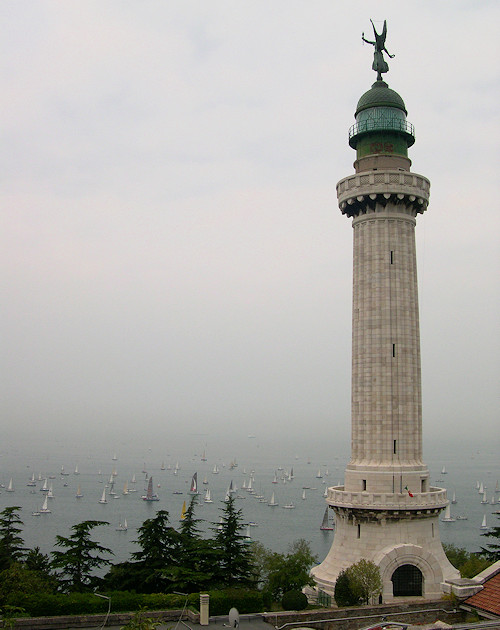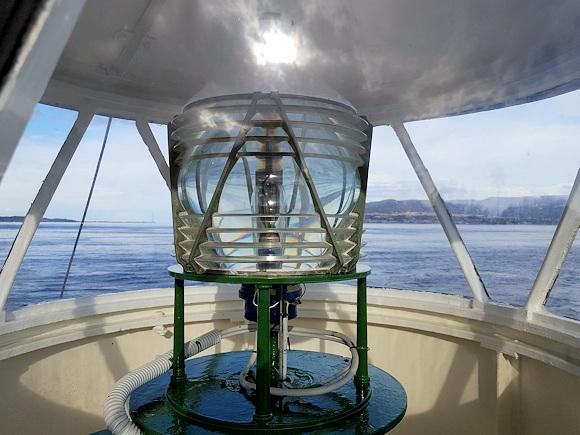The headlights have always aroused a certain fascination, populating the collective imagination with imposing buildings that dominate the seas, from which mighty swords of light depart, able to comfort sailors, illuminating the darkest nights.
The first Italian lighthouses were inherited by the pre-unitary marinas, with documentable traces dating back to the 1128 for the Lanterna of Genoa and to the 1303 for the Livorno lighthouse. The strengthening of the Italian network of maritime signaling was one of the first public works carried out after the unification of Italy, starting with the 1860.
With these premises, from the 1911 - ex lege - the National Headlights Service is entrusted to the Navy which ensures its operation through the Headquarters and Signaling Headquarters of the Logistic Command, based in Naples, with managerial functions and study responsibility, planning, management and control. The executive tasks are carried out by 6 Headlights Zone Commands, appropriately located throughout the national territory and divided into regencies, supervised by the farists, historical figures originally evocative of a solitary life, but which today are in possession of vast technical knowledge more functional to the dynamic management of the current and more modern equipment.
The Headlights Zone Commands (CZF), based in La Maddalena, La Spezia, Naples, Messina, Taranto and Venice, as territorial organs, operate directly under the respective Maritime Command (NORTH, SOUTH, SICILY) and, within the their area of jurisdiction, are used to ensure the operational efficiency of the reports entrusted to them (see Article 175 of the TUOM). For functional aspects, the Headlight Area Commands also depend on the Logistic Command.
 The Logistics Command, through the Headlights and Signaling Directorate, uses the Lighthouses Technical Office, based in La Spezia, to carry out the technical and logistical functions for the benefit of the entire national network of maritime signaling and aids for the navigation. It carries out studies, researches and experiments on materials and technologies to be used in the field of maritime signage.
The Logistics Command, through the Headlights and Signaling Directorate, uses the Lighthouses Technical Office, based in La Spezia, to carry out the technical and logistical functions for the benefit of the entire national network of maritime signaling and aids for the navigation. It carries out studies, researches and experiments on materials and technologies to be used in the field of maritime signage.
The national network of maritime signaling is developed in the main ports and along the coasts of the peninsula and islands for a total, to date, of 866 navigation aids consisting of 154 headlights and 712 between headlights, buoys and luminous beams to which must be added complementary reports entrusted to public bodies and private subjects. The responsibility of the compliance of the signaling to the navigation requirements lies, however, in the Headlights Department, as the only national authority that expresses itself on the adequacy of the maritime signaling to the need of navigation (see article 172 of the TUOM).
All reports, which are directly managed or entrusted to other bodies, are registered in the specific List of Headlights published and constantly updated by the Hydrographic Institute of the Navy.
The Code of the Military Order, the Consolidated Text of the regulatory provisions on the subject of Military Law, constitute the normative sources of the Service while the ministerial decrees and recommendations of the "International Association of Lighthouse Authorities" of which Italy is a member, define it performance objectives.

The current configuration / articulation must be read as the result of a long and progressive evolution characterized by the modernization and renewal of the Service of Lighthouses and Maritime Signaling - still in progress - which, through the adoption of equipment and plants at the forefront in the sector, technologically advanced and highly automated, as well as adoption - at the CC.ZZ.FF. - of the Emergency Response teams, aims to pursue high standards of efficiency and reliability.
Starting from the 2012, signaling modernization was also followed, characterized by the progressive electrification of the light sources of all the lights and by the automation of the slave systems.
Even the supply of maritime signaling has evolved, taking advantage of photovoltaic energy as a primary power source, while incandescent lamps have been replaced by new LED light sources, characterized by longer life and lower energy consumption.
In parallel, the professional figures and the tasks of the personnel have also changed: from the "fire officer" of the past, we have come to today's "technical-nautical assistant", in possession of more elaborate technical knowledge and functional to the new requirements of the Headlights Service.
This is the season that we are still experiencing, where the laborious work of transporting the cylinders to feed the light sources of the past, the complex transfer of the pharynxists - by motorboat or by cableway - to the more isolated or difficult to reach lighthouses, has now left the place to more qualified remote management capabilities of the signals: the so-called "telemonitoring".
From a sedentary, almost romantic concept based on a direct relationship between lighthouse and headliner, we have therefore moved on to a more dynamic relationship based on the technical skills and the ability to provide prompt assistance from the staff.
The farista staff, in fact, is currently assisted by special emergency teams capable of promptly restoring the functioning of the signals, allowing the Navy Headlights Service to ensure their efficiency at levels well above the standards set in the national field. international and provide - without interruption - an indispensable service in favor of the whole community of military, commercial, leisure, national and foreign sailors, contributing to the safety of navigation.

The emergency response teams vary their composition by quantity and specialization of the operators, up to integrating also personnel and structures of the Coast Guard which, pursuant to law, contributes to the monitoring of the signals and to the support of the maintenance activity dedicated to them.
The new and more specialized figures of the farista staff, the technological modernization, the experimentation of new buoys and light sources, are the main ingredients that have allowed in the last three years to record an increase in signaling efficiency of over 2%, ( 97% in 2015 compared to 99,03% in 2018), in a particularly critical range of variation dynamics, while the number of corrective actions has progressively reduced by more than 30% passing from 450 necessary interventions in 2015 to about 300 made in 2018.
The result achieved - already remarkable in itself - assumes connotations of extraordinary value when compared to the limited resources available, to the age of the signaling park and to the fleet as well as to the increase in the severity of the meteorological conditions that often occurred, as a confirmation of the validity of the choices made for the efficiency and sustainability of the Lighthouses and Signaling Service of the Logistic Command of the Italian Navy.
Lux nautis securitas!

NOTE: Article published courtesy of Navy Newsletter (April 2019)












